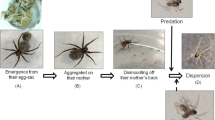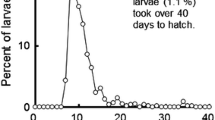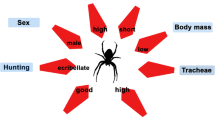Summary
The energy content of spider eggs was determined on samples from 12 species representing 6 families. These values ranged from 26.32 to 29.00 joules per mg ash-free dry mass with a mean of 27.30±SE of 0.27. The higher values were found in those species that overwinter as developmental stages within the egg sac. Rates of energy expenditure of developing eggs and spiderlings within the egg sac were only 7 to 19% of those of emerged spiderlings. The energy conserved by this reduction in rate of metabolism may facilitate survival without feeding during the potentially long periods of aerial dispersal by ballooning, a characteristic activity of most newly emerged spiderlings. The variation in mass-specific energy content is less than variation in clutch size and individual egg size on an intra-and interspecific basis. There was no correlation between energy content per unit egg mass and size of the female parent, egg size, or clutch size. Further analysis indicated that no single measure such as clutch size accurately represents the proportional amount of energy invested in reproduction in these animals.
Similar content being viewed by others
References
Allen, W.V.: Biochemical aspects of lipid storage and utilization in animals. Am. Zool. 16, 631–647 (1976)
Anderson, J.F.: Metabolic rates ofspiders. Comp. Biochem. Physiol. 33, 51–72 (1970)
Anderson, J.F.: Responses to starvation in the spiders Lycosa lenta Hentz and Filistata hibernalis (Hentz). Ecol. 55, 576–585 (1974)
Ballinger, R.E., Clark, D.R.: Energy content of lizard eggs and the measurement of reproductive effort. J. Herpetology 7, 129–132 (1973)
Bristowe, W.S.: The comity of spiders, Vol. 1. London: Ray Society 1939
Bristowe, W.S.: The world of spiders. London: Collins 1958
Carrel, J.E., Heathcote, R.D.: Heart rate in spiders: influence of body size and foraging energetics. Sci. 193, 148–150 (1976)
Downer, R.G.H., Matthews, J.R.: Patterns of lipid distribution and utilization in insects. Am. Zool. 16, 733–745 (1976)
Duffy, E.J.: Aerial dispersal in a known spider population. J. Anim. Ecol. 25, 85–111 (1956)
Edgar, W.D.: Aspects of the ecological energetics of the wolf spider Pardosa, (Lycosa) lugubris (Walckenaer). Oecologia (Berl.) 7, 136–154 (1971)
Enders, F.: Clutch size related to hunting manner of spider species. Ann. Entomol. Soc. Am. 69, 991–998 (1976)
Gertsch, W.J.: American spiders. Princeton: Van Nostrand 1949
Golley, F.B.: Energy values of ecological materials. Ecol. 42, 581–584 (1961)
Hagstrum, D.W.: Ecological energetics of the spider Tarentula kochi (Araneae: Lycosidae). Ann. Entomol. Soc. Am. 63, 1279–1304 (1970)
Harper, C.A.: Comparative ecology of two sibling species of wolf spiders (Araneae, Lycosidae). Ph.D. Thesis, University of Florida (1971)
Horner N.V.: Annual aerial dispersal of jumping spiders in Oklahoma. J. Arachnol. 2, 101–105 (1975)
Kaston, B.J.: Spiders of Connecticut. Hartford, Conn: State Geol. Nat. Hist. Bull. No. 70 (1948)
Kessler, A.: Relation between egg production and food consumption in species of the genus Pardosa (Lycosidae) Araneae under experimental conditions of food-abundance and food-shortage. Oecologia (Berl.) 8, 93–109 (1971)
Kessler, A.: A comparative study of the production of eggs in, eight Pardosa species in the field (Araneae, Lycosidae). Tijdschr. Entomol. 116, 23–41 (1973)
Kleiber, M.: The fire of life. New York: Wiley 1961
Levi, H.W.: The spider genera Gea and Argiope in America (Araneae: Araneidae). Bull. Mus. Comp. Zool. 136, 319–352 (1968)
Levi, H.W.: The orb-weaver genera Araniella and Nuctenea (Araneae: Araneidae). Bull. Mus. Comp. Zool. 146, 291–316 (1974)
Levi, H.W.: The orb-weaver genera Verrucosa, Acanthepeira, Wagneriana, Acacesia, Wixia, Scoloderus, and Alpaida north of Mexico (Araneae: Araneidae). Bull. Mus. Comp. Zool. 147, 351–391 (1976)
Marx, G.: Retardation in Argiope basilica. Proc. Entomol. Soc. Washington 1, 91 (1888)
McNab, B.K.: Food habits, energetics, and population biology in small mammals. Submitted for publ. (1978)
Mitchell, R., Downhower, J.F.: Energetics and fitness introduction to the symposium. Ohio J. Sci. 74, 337–338 (1974)
Moulder, B.C., Reichle, D.E.: Significance of spider predation in the energy dynamics of forest-floor arthropod communities. Ecol. Monogr. 42, 473–498 (1972)
Myrcha, A., Stejgwiłło-Laudańska, B.: Changes in the body's calorific value during starving of the Lycosa sp. (Araneidae). Bull. Acad. Polonaise Sci. 17, 291–294 (1969)
Paine, R.T.: The measurements and application of the calorie to ecological problems. Ann. Rev. Ecol. System. 2, 145–164 (1971)
Phillipson, J.: A miniature bomb calorimeter for small biological samples. Oikos 15, 130–139 (1964)
Pianka, E.R.: Natural selection of optimal reproductive tactics. Am. Zool. 16, 775–784 (1976)
Prakash, R.N., Pandian, T.J.: Energy flow from spider eggs through dipteran parasite and hymenopteran hyperparasite populations. Oecologia (Berl.) 33, 209–219 (1978)
Prestwich, K.N.: The energetics of web-building in spiders. Comp. Biochem. Physiol. 57 A, 321–326 (1977)
Rakotovao, L.H., Rahandraha M.T.: Variations de la teneur en eau et du taux lipidique en fonction de l'état physiologique de Nephila madagascariensis female adults. C.R. Acad. Sci. Paris 277 ser. D, 1517–1520 (1973)
Ralph, C.L. Introductory animal physiology, New York: McGraw-Hill 1978
Richter, C.J.J.: Aerial dispersal in relation to habitat in eight wolf spider species (Pardosa, Araneae, Lycosidae). Oecologia (Berl.) 5, 200–214 (1970)
Riechert, S.E., Tracy, C.R.: Thermal balance and prey availability: bases for a model relating web-site characteristics to spider reproductive success. Ecol. 56, 265–284 (1975)
Salmon, J.T., Horner, N.V.: Aerial dispersion of spiders in north central Texal J. Arachnol. 5, 153–157 (1977)
Savory, T.H.: The biology of spiders. London: Sidgwick and Jackson 1928
Schaefer, M.: An analysis of diapause and resistance in the egg stage of Floronia bucculenta. (Araneida: Linyphiidae). Oecologia (Berl.) 25, 155–174 (1976)
Siegel, S.: Nonparametric statistics: for the behavioral sciences. New York: McGraw-Hill 1956
Stearns, S.C.: Life-history tactics: a review of the ideas. Quart. Rev. Biol. 51, 3–47 (1976)
Tinkle, D.W., Hadley, N.F.: Reproductive effort and winter activity in the viviparous montane lizard Sceloporus jarrovi. Copeia 2, 272–277 (1973)
Tinkle, D.W., Hadley, N.F.: Lizard reproductive effort: caloric estimates and comments on its evolution. Ecol. 56, 427–434 (1975)
Turnbull, A.L.: The search for prey by a web-building spider Achaearanea tepidariorum (C.L. Koch) (Araneae, Theridiidae). Can. Entomol. 96, 568–579 (1964)
Valerio, C.E.: Feeding on eggs by spiderlings of Achaearanea tepidariorum (C.L. Koch) (Araneae, Theridiidae), and the significance of the quiescent instar in spiders. J. Arachnol. 2, 57–63 (1974)
Valerio, C.E.: A unique case of mutualism. Am. Nat. 109, 235–238 (1975)
Valerio, C.E.: Egg production and frequency of oviposition in Achaearanea tepidariorum (Araneae, Theridiidae). Bull. Brit. Arachnol. Soc. 3, 194–198 (1976)
Valerio, C.E.: Population structure in the spider Achaeranea tepidariorum (Araneae, Theridiidae). J. Arachnol. 3, 185–190 (1977)
Van Hook, R.I.: Energy and nutrient dynamics of spider and orthopteran populations in a grassland ecosystem. Ecol. Monogr. 41, 1–26 (1971)
Whitcomb, W.H., Hite, M., Eason, R.: Life history of the green lynx spider, Peucetia viridans (Araneida: Oxyopidae). J. Kansas Entomol. Soc. 39, 259–267 (1966)
Wiegert, R.G., Intraspecific variation in calories/g of meadow spittlebugs (Philaenus spumarius L.). Bio. Sci. 15, 543–545 (1965)
Wise, D.H.: Food limitation of the spider Linyphia marginata: experimental field studiew. Ecol. 56, 637–646 (1975)
Author information
Authors and Affiliations
Rights and permissions
About this article
Cite this article
Anderson, J.F. Energy content of spider eggs. Oecologia 37, 41–57 (1978). https://doi.org/10.1007/BF00349990
Received:
Issue Date:
DOI: https://doi.org/10.1007/BF00349990




